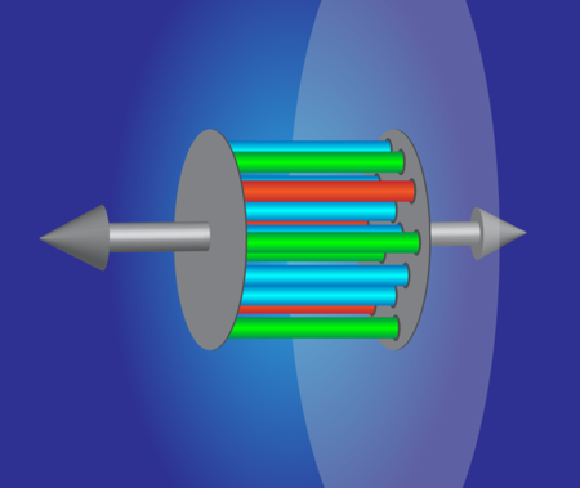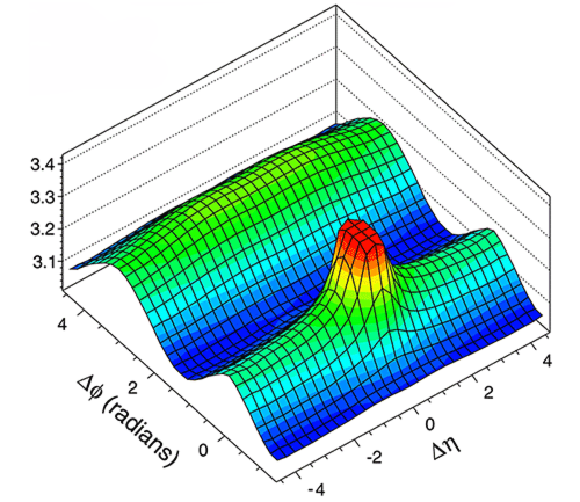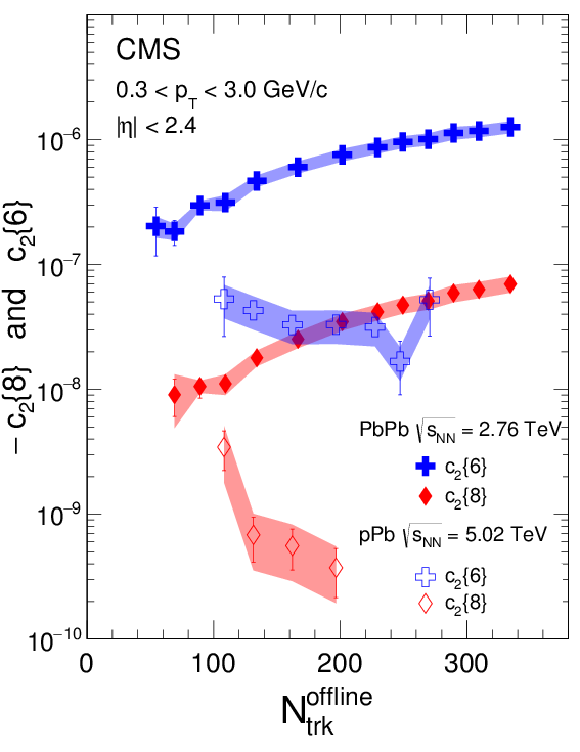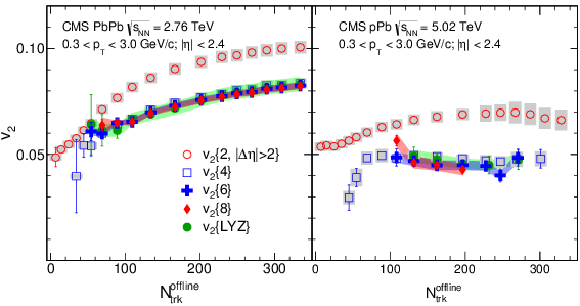

Compact Muon Solenoid
LHC, CERN
| CMS-HIN-14-006 ; CERN-PH-EP-2015-011 | ||
| Evidence for collective multi-particle correlations in pPb collisions | ||
| CMS Collaboration | ||
| 18 February 2015 | ||
| Phys. Rev. Lett. 115 (2015) 012301 | ||
| Abstract: The second-order azimuthal anisotropy Fourier harmonics, $v_2$, are obtained in pPb and PbPb collisions over a wide pseudorapidity ($\eta$) range based on correlations among six or more charged particles. The pPb data, corresponding to an integrated luminosity of 35 nb$^{-1}$, were collected during the 2013 LHC pPb run at a nucleon-nucleon center-of-mass energy of 5.02 TeV by the CMS experiment. A sample of semi-peripheral PbPb collision data at $\sqrt{s_{\mathrm{NN}}}$ = 2.76 TeV, corresponding to an integrated luminosity of 2.5 $\mu$b$^{-1}$ and covering a similar range of particle multiplicities as the pPb data, is also analyzed for comparison. The six- and eight-particle cumulant and the Lee-Yang zeros methods are used to extract the $v_2$ coefficients, extending previous studies of two- and four-particle correlations. For both the pPb and PbPb systems, the $v_2$ values obtained with correlations among more than four particles are consistent with previously published four-particle results. These data support the interpretation of a collective origin for the previously observed long-range (large $\Delta\eta$) correlations in both systems. The ratios of $v_2$ values corresponding to correlations including different numbers of particles are compared to theoretical predictions that assume a hydrodynamic behavior of a pPb system dominated by fluctuations in the positions of participant nucleons. These results provide new insights into the multi-particle dynamics of collision systems with a very small overlapping region. | ||
| Links: e-print arXiv:1502.05382 [nucl-ex] (PDF) ; CDS record ; inSPIRE record ; Public twiki page ; HepData record ; CADI line (restricted) ; | ||
| PRL Editor's Suggestion, Featured in Physics | |

png ; pdf |
(not a CMS figure) Figure from ``Viewpoint: The Littlest Liquid'', by Jean-Yves Ollitrault (IPhT, Paris-Saclay, France). The CMS researchers studied the quark-gluon plasma produced by the collision between a high-energy proton and a lead nucleus. Relativistic effects flatten the two projectiles (gray disks) along the line of collision. The diagram indicates the density variations (colors) from quantum fluctuations in the lead nucleus, which are imprinted on the resulting plasma as correlations between particles. |

png ; pdf |
(not a CMS figure) Figure from ``Viewpoint: The Littlest Liquid'', Jean-Yves Ollitrault (IPhT, Paris-Saclay, France). Pairwise correlations between particles in the plasma produced by a collision between a proton and a lead nucleus. The correlations have a wavelike pattern along the azimuthal angle ($\Delta \phi$) and are essentially independent of the longitudinal separation ($\Delta \eta$) between the particles. |
| Figures | |

png pdf |
Figure 1:
The cumulant $c_2\{6\}$ and $-c_2\{8\}$ results as a function of $ {N_\text {trk}^\text {offline}} $ for PbPb and pPb reactions. Error bars and shaded areas denote statistical and systematic uncertainties, respectively. |

png pdf |
Figure 2:
The $v_2$ values as a function of $ {N_\text {trk}^\text {offline}} $. Open data points are published two- and four-particle $v_2$ results. Solid data points are $v_2$ results obtained from six- and eight-particle cumulants, and LYZ methods, averaged over the particle $ {p_{\mathrm {T}}} $ range of 0.3-3.0 GeV/$c$, in PbPb at $ {\sqrt {s_{_\mathrm {NN}}}} =$ 2.76 TeV (a) and pPb at $ {\sqrt {s_{_\mathrm {NN}}}} =$ 5.02 TeV (b). Statistical and systematic uncertainties are indicated by the error bars and shaded regions, respectively. |

png pdf |
Figure 3:
Cumulant ratios $v_2\{6\}/v_2\{4\}$ (top) and $v_2\{8\}/v_2\{6\}$ (bottom) as a function of $v_2\{4\}/v_2\{2\}$ in pPb collisions at $ {\sqrt {s_{_\mathrm {NN}}}} =$ 5.02 TeV and PbPb collisions at $ {\sqrt {s_{_\mathrm {NN}}}} =$ 2.76 TeV. Error bars and shaded areas denote statistical and systematic uncertainties, respectively. The solid curves show the expected behavior based on a hydrodynamics motivated study of the role of initial-state fluctuations. |
| Summary |
| In summary, multi-particle azimuthal correlations among six, eight, and all particles have been measured in pPb collisions at $\sqrt{s_{\mathrm{NN}}} =$ 5.02 TeV by the CMS experiment. The new measurements extend previous CMS two- and four-particle correlation analyses of pPb collisions and strongly constrain possible explanations for the observed correlations. A direct comparison of the correlation data for pPb and PbPb collisions is presented as a function of particle multiplicity. Averaging over the particle $p_{\mathrm{T}}$ range of 0.3-3.0 GeV/$c$, multi-particle correlation signals are observed in both pPb and PbPb collisions. The second-order azimuthal anisotropy Fourier harmonic, $v_2$, is extracted using six- and eight-particle cumulants and using the LYZ method which involves all particles. The $v_2$ values obtained using correlation methods including four or more particles are consistent within 2%for the PbPb system, and within 10% for the pPb system. This measurement supports the collective nature of the observed correlations. The ratios of $v_2$ values obtained using different numbers of particles are found to be consistent with hydrodynamic model calculations for pPb collisions. |

|
Compact Muon Solenoid LHC, CERN |

|

|

|

|

|

|